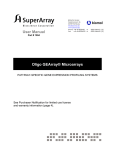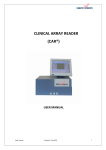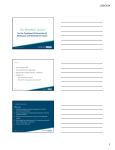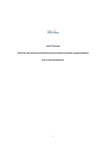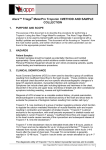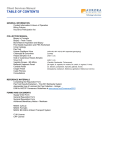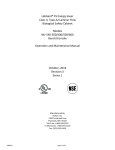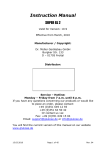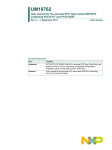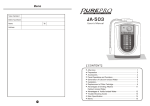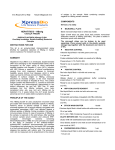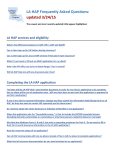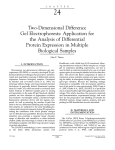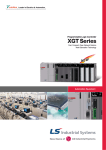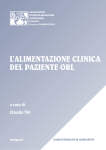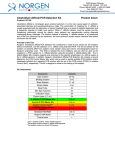Download USER MANUAL MEDICAL MICROBIOLOGY
Transcript
MEDICAL MICROBIOLOGY DEPARTMENT OF PATHOLOGY, HOSPITAL PULAU PINANG MEDICAL MICROBIOLOGY BACTERIOLOGY GENERAL 1. Properly collected specimens should be sent to the laboratory during office hours without delay in order to avoid overgrowth of commensals or loss of viability of pathogens. 2. Specimens should be collected from correct anatomic sites using proper techniques to avoid contamination from indigenous flora. 3. Specimens should be collected before antibiotics are given, if possible. If antibiotics are given, indicate on the request form. 4. Specimens collected should be of adequate volume and be placed in appropriate containers. 5. Each specimen should be accompanied by fully completed PER-PAT 301 request form. SPECIMEN COLLECTION Collection of Cerebrospinal Fluid (CSF) for culture and sensitivity (C&S) or Bacterial Antigen Detection. 1. Disinfect the skin over the lumbar puncture site. 2. Observing aseptic techniques perform a lumbar puncture and collect about 3 – 4 ml of CSF in a sterile container. 3. Send the specimen immediately to the laboratory. DO NOT STORE IN A REFRIGERATOR, as organisms causing meningitis are usually very sensitive to cold. Other body fluids for C&S 1. Transfer pleural, pericardial, peritoneal and synovial fluids aspirated aseptically to a sterile screw capped bottle and send to the laboratory without delay. 2. If delay is unavoidable, store at RT for < 24 hours except for pericardial fluid which should be stored at 40C USER MANUAL HPP/PAT/USER MANUAL/MM/VER 4.1/DECEMBER 2014 1 MEDICAL MICROBIOLOGY DEPARTMENT OF PATHOLOGY, HOSPITAL PULAU PINANG Ear Swab 1. The external meatus is cleaned with a dry swab moistened with sterile saline. Let the site dry before sampling. 2. Pass a swab gently into the external canal and collect whatever exudate is found there. 3. Place the swab in its carrier-tube or transport media and send the specimen to the laboratory as soon as possible. Eye Swab 1. Collect the exudates with separate sterile swabs. 2. Place the swab into a transport medium and send it together with a fixed smear of the exudates to the lab. 3. For the isolation of Neisseria gonorrhoeae, inoculate the specimen onto a GCLect Agar plate in a ‘Z’ fashion by the bedside. Place the plate in a covered tin container. Light a candle, place it in the tin and close the lid. Send the covered tin container as soon as possible to the laboratory. Note: The tin and GC Lect agar are available on request from the laboratory. Stool Note: Bedpans or collecting specimens for culture should be cleaned. Fresh stool 1. Using a swab, collect a small amount of stool, by dipping and rotating in the faeces, taking care to include materials containing pus, mucus or blood if present 2. Place the swab with the stool into a sterile universal container, screw the cap tightly and send it immediately to the laboratory. 3. If delay is unavoidable, store at 40C for < 24 hours in respective ward. USER MANUAL HPP/PAT/USER MANUAL/MM/VER 4.1/DECEMBER 2014 2 MEDICAL MICROBIOLOGY DEPARTMENT OF PATHOLOGY, HOSPITAL PULAU PINANG Rectal swab Note: Rectal swab should only be taken if a stool specimen is not available. It is a less satisfactory specimen than stool. 1. Insert a sterile swab deep into the anus 1 inch beyond the anus sphincter so that the swab may come into contact with some faecal material. A satisfactory rectal swab is one, which shows some faecal staining. 2. Send the specimen to the laboratory as soon as possible. Dip the rectal swab into the appropriate enteric transport medium as below: a. Cary Blair Medium : suitable for most enteropathogenic bacteria b. Selenite F Broth : specifically for Salmonella sp. c. Alkaline Peptone Water : for V. cholerae and other vibrios. Send specimen to microbiology laboratory as soon as possible. Tuberculosis Sputum 1. Sputum is preferably collected when the patient first wakes up in the morning. Gargle mouth before sputum collection. 2. Ask the patient to spit directly into a screw-capped sterile container. expectorated is sputum and not saliva. Ensure that the 3. Send the specimen immediately to the laboratory. If delay is unavoidable, store it in a refrigerator. 4. Send the sputum AFB direct smear (D/S) and sputum AFB C&S to TB Lab (103). Other specimens: 1. Collect specimens aseptically. 2. Transfer into sterile bottle and send to the lab without delay. If delay is unavoidable, store it in a refrigerator. Blood/ Bone marrow aspirate for TB 1. For the isolation of Mycobacterium from blood; especially in HIV patient, BACTEC MYCO F/LYTIC is used.The BACTEC MYCO F/LYTIC can be obtained from TB Lab (Ext. 5216). USER MANUAL HPP/PAT/USER MANUAL/MM/VER 4.1/DECEMBER 2014 3 MEDICAL MICROBIOLOGY DEPARTMENT OF PATHOLOGY, HOSPITAL PULAU PINANG 2. Only a single specimen is required. For instruction of blood collection for BACTEC MYCO F/LYTIC, please refer Blood C&S (Blood Culture Bottles). 3. Send the blood AFB Bactec to TB lab. Blood C&S (Blood Culture Bottles) Collection procedure 1. Check blood culture medium for contamination before use. Bottles with gross turbidity should be returned to the lab. 2. Disinfection of culture bottle: Apply 70% alcohol to rubber stopper and allow to air dry. 3. Disinfection of venepuncture site: 4. Cleanse site with 70% alcohol. 5. Swab concentrically, starting at centre with iodine and allow to dry. 6. Do not palpate vein at this point. 7. Withdraw 5 -10ml of blood for adults or 1 - 4 ml of blood for infants. 8. Send specimen to lab immediately. If delay is inevitable, keep bottle culture at RT; for not more than 24 hours. General Recommendations Acute sepsis: 2-3 sets from separate sites, all taken within 10 minutes. Acute endocarditis: 3 sets from 3 sites, each 1 - 2 hr apart within 24 hrs. Subacute endocarditis: 3 sets from 3 sites taken > 15 minutes apart within 24 hrs. Fever of unknown origin: 2 - 3 sets from separate sites > 1 hour apart. Only one blood culture bottle should be inoculated at one time from one venepuncture site. For suspected catheter-related bloodstream infection (CRBSI), send specimen in pairs, taken from peripheral (skin site) and from central catheter (ONLY FROM ONE CATHETER), and note the time taken in the PER-PAT 301 form. USER MANUAL HPP/PAT/USER MANUAL/MM/VER 4.1/DECEMBER 2014 4 MEDICAL MICROBIOLOGY DEPARTMENT OF PATHOLOGY, HOSPITAL PULAU PINANG Sputum for C&S Sputum, expectorate 1. Ask patient to rinse and gargle mouth with water. 2. Instruct patient to cough deeply to produce lower respiratory specimen and collect sputum in a sterile container. 3. Send specimen immediately to laboratory. Nasal swab for C&S 1. Moistened swab with sterile saline before sampling. 2. Rotate the swab over the mucosa of the nasal cavity. 3. Replace the swab in its carrier-tube or transport media and send the specimen to the laboratory immediately. Throat Swab for C&S 1. Insert the swab carefully through the mouth with the tongue depressed. 2. Rub swab over each tonsillar area and the posterior pharynx. Any area with exudates should be sampled. 3. Do not allow swab to touch tongue or lips. 4. Replace swab in its carrier tube or transport media and send to the laboratory immediately. If Corynebacterium diphtheriae is suspected: 1. Lift edge of the membrane and swab under it. 2. Obtain at least 2 swabs and send to the lab immediately. USER MANUAL HPP/PAT/USER MANUAL/MM/VER 4.1/DECEMBER 2014 5 MEDICAL MICROBIOLOGY DEPARTMENT OF PATHOLOGY, HOSPITAL PULAU PINANG Nasopharyngeal Swab for C&S Note: The nasopharyngeal swab for whooping cough is obtainable from Microbiology lab. 1. This is especially useful for the diagnosis of whooping cough. 2. A special swab mounted on a soft flexible wire is used. 3. Pass the swab gently through the nostril and along the floor of the nasal cavity into the posterior nasopharynx, rotate it and withdraw. 4. Culture directly onto charcoal agar at bedside and dispatch the specimen to the laboratory immediately. Tracheal aspirate, Bronchoalveolar lavage (BAL), Bronchial washings 1. Place aspirate or washing in sterile container. 2. Send to lab immediately. 3. If delay is unavoidable, store in refrigerator for < 24 hours. Urine for C&S 1. Collect 25 ml of midstream urine in a sterile container. Early morning urine is preferable to enable the organism to multiply in the bladder before collection. If not possible a period of 3 hours must elapse after the last urination. 2. Male patients should cleanse the glans penis with plain soap and water after retracting the foreskin. 3. Female patients should similarly cleanse the labial folds and vulva. 4. Discard the first portion of voided urine and collect the midstream urine directly into a sterile container Note: The specimen should reach the laboratory within 1 hour after collection. In case of delay, store at 40C for not more than 24 hours. Urine for Microscopy and Urinalysis (Qualitative) 1. Collect 25 ml of a clean catch of midstream urine into a sterile container without preservatives. 2. Send to the lab immediately. USER MANUAL HPP/PAT/USER MANUAL/MM/VER 4.1/DECEMBER 2014 6 MEDICAL MICROBIOLOGY DEPARTMENT OF PATHOLOGY, HOSPITAL PULAU PINANG Mycological Examination (microscopy) for hair, skin, nail 1. Specimen for the diagnosis of hair dermatophytosis should include affected hair with bases of shafts intact. 2. For skin dermatophytosis or primary cutaneous candidiasis obtain skin specimens by scraping the active borders of the lesion with a blunt sterile scalpel after wiping the affected area with alcohol swab. 3. Obtain nail specimens by clipping the affected area of nail and include scrapings of the excess keratin produced beneath the nail. 4. Place all hair, skin and nail specimens in a clean envelope or sterile container for transport to the laboratory. If storage required, store at room temperature. Tissue for C&S 1. Collect tissue and transfer aseptically into a sterile container. 2. Do not add any fluid or formalin. 3. Send immediately to the lab. Collection of Pus Aspirate 1. Clean the skin over the inflamed area by wiping with sterile saline or 70% alcohol. 2. With a sterile syringe, aspirate the pus or exudate and transfer the pus into a sterile container. 3. Send the specimen immediately to the laboratory. DO NOT STORE IN A REFRIGERATOR. Note: Tissue or fluid is always superior to swab specimen. If swab must be used, pass swab deep into lesion and preserve it in Stuart's or Amies Transport medium. Culture for Gonococci 1. For optimum recovery, exudate from relevant sites should be immediately streaked onto GC Lect Agar plates (allow to reach room temperature before use). 2. Send to the laboratory immediately in a candle jar Note: GC Lect Agar plates and candle jar can be obtained from the lab on request. The above specimen is to be accompanied by a smear for gram stain. USER MANUAL HPP/PAT/USER MANUAL/MM/VER 4.1/DECEMBER 2014 7 MEDICAL MICROBIOLOGY DEPARTMENT OF PATHOLOGY, HOSPITAL PULAU PINANG Genital specimens Endocervical swab 1. Visualize cervix using speculum without lubricant. 2. Remove mucus and secretions from cervix with swab and discard swab. 3. Sample endocervical canal with sterile swab. 4. Proceed as in 2.18 for gonococci culture. Note: Endocervical swabs should be taken for culture of gonococci. HVS are not suitable. High vaginal swab (HVS) 1. Wipe away excess amount of secretion/discharge. 2. Obtain secretion from mucosal membrane of vaginal vault with sterile swab and send swab to the lab in transport media. Note: For intrauterine device, place the entire device into sterile container and send to lab at RT. Urethral swab 1. Insert swab 3 – 4 cm into the anterior urethra. 2. Leave the swab in place for few seconds to allow saturation with exudates. 3. Proceed as in 2.18 for gonococci culture. Clostridium difficile in stool 1. Collect fresh stool (approx. 1 tablespoonful) in a sterile bottle. 2. Send to the lab immediately. Note: Please include the relevant clinical summary for this test as follows: a. b. c. Antibiotic-associated diarrhea Colitis Pseudomembranous colitis In-use test for disinfectants 1. Aseptically transfer 5 ml of disinfectant into a sterile bottle. 2. Send to the lab immediately. USER MANUAL HPP/PAT/USER MANUAL/MM/VER 4.1/DECEMBER 2014 8 MEDICAL MICROBIOLOGY DEPARTMENT OF PATHOLOGY, HOSPITAL PULAU PINANG Spore Test (Autoclave) 1. Send Attest indicator vials that have gone through the autoclaving cycle together with an unautoclaved Attest (Control) to the lab. 2. Ensure that both test and control Attest are from the same batch. Note: The same applies to Spore Strips. Urease test for H. pylori organism 1. Place a tiny piece of tissue into the urease medium. 2. Send to the lab as soon as possible together with an uninoculated tube of the urease medium as control. Catheter tip 1. Clean the skin around the catheter site with alcohol. 2. Aseptically remove and clip 5cm distal tip of catheter into sterile container and send immediately to lab. 3. Store in refrigerator for < 24 hours if delay is unavoidable. Note: Catheter tips SHOULD ONLY be sent insuspected catheter related infection Foley's catheter is not acceptable for culture since growth represent distal urethral flora. Blood Film Filaria Parasite (BFFP) 1. Before collecting blood disinfect the venepuncture site as in 2.7. 2. Collect 5 ml of blood in an EDTA tube and send to the laboratory. 3. Prepare a thick smear on slides. 4. Leave to dry and send them together with the blood tube to the laboratory. Blood Film Malaria Parasite (BFMP) 1. Before collecting blood disinfect the venepuncture site as in 2.7. 2. Collect 5 ml of blood in an EDTA tube and send to the laboratory. 3. Prepare a thick and thin smear on slides. 4. Leave to dry and send them together with the blood tube to the laboratory. USER MANUAL HPP/PAT/USER MANUAL/MM/VER 4.1/DECEMBER 2014 9 MEDICAL MICROBIOLOGY DEPARTMENT OF PATHOLOGY, HOSPITAL PULAU PINANG Environmental sampling 1. Aseptically transfer 5ml of specimen into a sterile bottle. 2. For settle plate, the media plates are available from the laboratory upon request. Note: All the environment specimens ONLY can be received from Infection Control Nurse under special circumstances (e.g. outbreak). Stool for Acute Flaccid Paralysis Surveillance 1. Collect 2 specimens, at least 24 hours apart, and within 14 days of the onset (or as soon as possible thereafter). of paralysis 2. Use small, clean, leak proof containers to collect sufficient amount of stool (i.e. adult thumb size). No need for sterile containers or transport media. 3. Send directly to Serology Lab as soon as possible. Specialized Virology test (Out-sourced Test, refer to Appendix III) Direct Antigen Detection (Immunofluorescence antibody test - IFAT) Respiratory specimens Sputum 1. Ask patient to cough deeply and spit directly into a sterile container. 2. Expectorate should be the secretions from the bronchi and not just saliva. Tracheal aspirate / Nasopharyngeal aspirate and Bronchoalveolar lavage (BAL) 1. Place the specimen obtained via the above methods into a sterile container. Throat swab and nasal swab 1. Put the swab into the Viral Transport Medium (VTM). VTM is available from the laboratory upon request. Viral Genome Detection (PCR), please specify the virology tests needed Blood 1. Collect 3-5ml of blood into plain tube (without anticoagulant). 2. Sent directly to Serology Lab within 4 hours after being taken. USER MANUAL HPP/PAT/USER MANUAL/MM/VER 4.1/DECEMBER 2014 10 MEDICAL MICROBIOLOGY DEPARTMENT OF PATHOLOGY, HOSPITAL PULAU PINANG CSF 1. Collect min of 0.3ml of CSF into sterile container 2. Packed in ice for transport. 3. Sent directly to Serology Lab within 2 hours after being taken. USER MANUAL HPP/PAT/USER MANUAL/MM/VER 4.1/DECEMBER 2014 11 MEDICAL MICROBIOLOGY DEPARTMENT OF PATHOLOGY, HOSPITAL PULAU PINANG MOLECULAR DIAGNOSTIC GENERAL All tests for HIV PCR viral load must be requested only by specialist. Additional rejection criteria specific for HIV viral load / H1N1 is implemented. Rejection criteria: HIV Viral Load a. Sample is collected in the heparin tube or serum separator tube/serum tube. b. Mislabelled or unlabelled specimens. c. No DATE and TIME of specimen collection and separation and dispatch, and no name/signature of dispatch personnel. d. No requesting Doctor’s/Officer in-charge AND Specialist name and stamp on the 1st and 2nd (copy) form. e. Requesting Clinic/Unit/Hosp and ward is not identified. f. Sample from non-HAART monitoring patients (Highly Active Antiretroviral Therapy) except for baseline screening. g. Plasma not removed from the red blood cells within 4 hours from collection time with the time of collection and time of separation stated. h. Improper specimen storage and transport. i. Specimen received after 5 days of separation of sample collection. j. Haemolysed or lipaemic samples. k. Specimen quantity not sufficient for testing (at least 3-5 ml of plasma). l. Less than 4 months repeated sample. USER MANUAL HPP/PAT/USER MANUAL/MM/VER 4.1/DECEMBER 2014 12 MEDICAL MICROBIOLOGY DEPARTMENT OF PATHOLOGY, HOSPITAL PULAU PINANG H1N1 a. Specimen received more than 24 hours. b. Mislabelled/unlabelled/incompletely labelled specimens. c. Tube labelled with only 1 identification. d. Improper specimen transport / storage. e. Sample leaking and not properly screwed. f. Specimen collected with calcium alginate swab or not in VTM. g. Quantity not sufficient i.e. < 2 ml. h. Inappropriate specimen types (e.g. urine, blood, body fluids). i. No facility information (e.g. ward, hospital etc.). COLLECTION OF SPECIMEN HIV Viral Load a. Collect 2 ml of blood in each 4 EDTA tubes. Important: DO NOT USE the Lithium Heparin tube, as it will inhibit the PCR process. b. Pack with ice and send in flask/suitable container. c. Send as soon as possible within 4 hours collection. d. LTAT: 14 working days. Note: For other hospital/clinic: a. Spin for plasma by centrifuge at 3000 rpm for 20 minutes and send only the plasma. b. Plasma may be transported and refrigerated at 2-8 ºC for up to 4 days or frozen at -20ºC to – 80ºC for >4days. USER MANUAL HPP/PAT/USER MANUAL/MM/VER 4.1/DECEMBER 2014 13 MEDICAL MICROBIOLOGY DEPARTMENT OF PATHOLOGY, HOSPITAL PULAU PINANG H1N1 PCR 1. Collect sample in VTM container. 2. Type of sample: a) Nasopharyngeal aspirate/wash b) Throat swab/gargle c) Tracheal aspirate d) Nasal swab 3. Transport in ice condition. 4. Request form must be attached outside of the box. LTAT: a) Urgent/critical case – 1 day b) Routine test – 3 days. USER MANUAL HPP/PAT/USER MANUAL/MM/VER 4.1/DECEMBER 2014 14 MEDICAL MICROBIOLOGY USER MANUAL DEPARTMENT OF PATHOLOGY, HOSPITAL PULAU PINANG HPP/PAT/USER MANUAL/MM/VER 4.1/DECEMBER 2014 15 MEDICAL MICROBIOLOGY DEPARTMENT OF PATHOLOGY, HOSPITAL PULAU PINANG SEROLOGY GENERAL Blood collected in plain container should be allowed to clot by standing undisturbed at room temperature. Clotted blood may then be stored at 4 0C if delay is unavoidable. Each specimen should be accompanied by fully completed PER-PAT 301 request form in duplicate. COLLECTION OF SPECIMEN For normal serologic and immunologic test 1. Aseptically collect 5 - 6 ml of venous blood into a sterile test tube. 2. Send the specimen to the serology laboratory immediately. 3. Frequency/LTAT– refer Appendix 1. Note: For district hospital, to avoid haemolysis, it is advisable to separate the serum in a sterile screw-capped container. The specimen must be sent to the serology lab as soon as possible. If there is any delay the serum must be kept at 4 0C. Urine for Pregnancy Test 1. Collect 10 ml of the first morning urine into a sterile container after overnight restriction fluid intake. of 2. Dispatch the specimen without delay to the laboratory. USER MANUAL HPP/PAT/USER MANUAL/MM/VER 4.1/DECEMBER 2014 16 MEDICAL MICROBIOLOGY DEPARTMENT OF PATHOLOGY, HOSPITAL PULAU PINANG Collection of Semen for Seminal Fluid Analysis 1. Collection should follow a period of sexual abstinence of 4 - 7 days. 2. The specimen is collected by masturbation or by coitus interuptus into a sterile screwcapped bottle. Note: 1. Condoms, even when thoroughly washed and rinsed, contain spermicidal agents, and must not be used. Exposure of spermatozoa to cold and heat should be avoided. 2. Note the date and exact time when the specimen is obtained. 3. The material should be examined within 1-3 hours. 4. It is preferred that patients obtain an appointment date from this laboratory before submitting their specimens for examination. Paired Serum for Dengue, Indirect Immunoperoxidase (IIP) Test for Typhus. 1. Collect blood by venepuncture into a sterile plain tube and allow it to clot. 2. LTAT: i. Dengue: 1 day (Weekend rapid test is done ii. IIP: 7 working days if < 5 samples.) Specimen for Chlamydia trachomatis Immunofluorescence Test Urethral Specimens Note: Because the passage of urine may dislodge cells from the urethra, instruct the patient to refrain from urinating for 1 hour prior to sampling. 1. Insert a small swab 2 - 4 cm into the urethra. (Rotate swab gently to aid in insertion). 2. Gently rotate swab using enough pressure to obtain epithelial cells. 3. Allow swab to remain inserted for 1 -2 seconds. 4. Withdraw swab and prepare slide immediately. 5. Send the slide immediately to the serology lab for processing. USER MANUAL HPP/PAT/USER MANUAL/MM/VER 4.1/DECEMBER 2014 17 MEDICAL MICROBIOLOGY DEPARTMENT OF PATHOLOGY, HOSPITAL PULAU PINANG Cervical Specimens Note: Specimen from female cervix should contain as many columnar epithelial cells as possible as C. trachomatis are intracellular organisms that infect these cells. (Sample collection kit can be obtained from serology lab ). 1. Clean cervix with a sterile cotton swab before sampling to remove excess mucus and exudate from the ectocervix. 2. Insert swab in the cervical canal and rotate at the squamo-columnar junction for 5 - 10 seconds. 3. If using the cytology brush, insert until more than half the bristles are inside the cervical opening. Slowly rotate the device one full turn. 4. Withdraw the collection device avoiding contact with vaginal surface. 5. Prepare direct specimen slide immediately. 6. Send the slide immediately to serology lab for processing. Ocular Specimens Note: If both eyes are infected, collect a sample from each eye and process as separate specimens. (Sample collection kit can be obtained from serology lab). 1. Pull down the lower eyelid of the patient to expose the conjunctiva. 2. Carefully remove any exudate or pus with a moist sterile swab. Discard swab into a biohazard container. 3. Using the sterile swab moistened with sterile saline, rotate gently but firmly against the conjunctival surface of the lower lid. Use care to avoid damaging the eye. 4. Prepare direct specimens slide immediately and send to lab. Note: Special sterile swab and Chlamydia single-well slides are obtainable from the Microbiology Lab upon request. Send slide to laboratory as soon as the smear is made because it needs to be fixed. USER MANUAL HPP/PAT/USER MANUAL/MM/VER 4.1/DECEMBER 2014 18 MEDICAL MICROBIOLOGY DEPARTMENT OF PATHOLOGY, HOSPITAL PULAU PINANG Specimen for Pneumocystis carinii Immunoflourescence Test Note: For maximum yield, it is important that appropriate clinical specimens are obtained. Induced sputum and bronchoalveolar lavage are the specimens of choice. (Spontaneously produced sputum, fluids obtained by transbronchial aspiration and bronchial wash or specimens obtained by bronchial brushing have a much lower diagnostic yield and are discouraged). 1. Collection of Induced sputum (please make appointment with serology lab before collecting sample). 2. Have patient to brush teeth, tongue and gums with toothbrush and 0.85% saline followed by thorough mouth rinsing. 3. With the aid of a nebulizer, have patient inhale 25 ml of 3% sterile saline. 4. Collect specimen into sterile container and send immediately to the lab. Important: Please label the request form with INDUCED sputum. Leptospirosis 1. Blood using plain bottle for serology and EDTA bottle for PCR 2. Each bottle should contain at least 3ml of whole blood 3. If available, CSF sample to be sent in sterile bottle 4. Completed laboratory form and specimen should be sent to IMR within 48 hours. 5. For post-mortem specimen should be taken under strictly aseptic technique. 6. Tissue samples (eg. brain, lung liver, heart, spleen and kidney) should be sent in duplicate in sterile container and formalin. Anti-HIV, HBsAg, HCV Test, Anti-HBs, Cytomegalovirus (CMV) Antibody IgG and IgM, Toxoplasma, Hepatitis B Neutralization Test 1. Collect 5.0 ml of blood into a sterile plain container. 2. Send the specimen to the laboratory immediately. 3. Routine LTAT: i. Anti-HIV, HBsAg, Anti-HCV and Anti-HBs tests - 3 working days. ii. Toxoplasma, CMV - 7 working days. iii. Hep B Confirmation - 5 samples per batch. Note: All requests must be accompanied with fully filled up PER-PAT 301 request form with patient's particulars, relevant clinical history, doctor's full name and signature. USER MANUAL HPP/PAT/USER MANUAL/MM/VER 4.1/DECEMBER 2014 19 MEDICAL MICROBIOLOGY DEPARTMENT OF PATHOLOGY, HOSPITAL PULAU PINANG Anti-HIV Immunoblot (refer special request form in Appendix IV) a. Collect 5.0 ml of blood into a sterile plain container. b. Send the specimen to laboratory immediately. c. Routine LTAT – 7 working days Note: Samples reactive for HIV antibody ELISA and/or positive for HIV PA will be confirmed using HIV immunoblot. A repeat sample is needed for confirmation diagnosis. ANA/DsDNA a. Collect 5.0 ml of blood into a sterile plain container. b. Routine LTAT – 7 working days. (DsDNA is done only if homogenous pattern is seen). CSF VDRL,Rapid Plasma Reagin Test (RPR), Rheumatoid Factor (RF), Anti-Streptolysin O Test (ASOT) a. CSF for VDRL is collected in a sterile container preferably sterile bijou bottle. b. RPR, RF and ASOT samples are collected in 5.0 ml of blood into a sterile plain tube. RPR blood sample also can be collected in heparin tube. c. LTAT - 1 working days. Anti-HIV 1& 2 Particle Agglutination (PA), HCV PA, TPPA and Mycoplasma a. Collect 5.0ml blood into a sterile plain tube. b. LTAT: 7 working days Needle Stick Injury (NSI) a. Must inform the lab immediately before sending the sample. b. Contact no: i.Office hour: 5987 ii.After office hour: 5152/5153/5987 c. Please send in pairs (except unknown source) and note on the form whether it is victim/staff or patient /source. d. Please state the status of NSI case (Review or new case). e. Anti-HIV, HBsAg, Anti HCV and RPR will be done within 1 day if the sample received during office hour. USER MANUAL HPP/PAT/USER MANUAL/MM/VER 4.1/DECEMBER 2014 20 MEDICAL MICROBIOLOGY f. DEPARTMENT OF PATHOLOGY, HOSPITAL PULAU PINANG After office hour, only rapid test for HIV and HBsAg will be done. The other tests such as ELISa test for anti-HIV, anti-HCV and HBsAG including RPR will be tested the next working day. g. New case result that is ready to dispatch shall be informed to Infection Control Team (IC Team). h. Review case result that is ready to dispatch shall be informed to Infectious Disease team (ID Team). Organ donor a. Please inform the lab after the organ donation team procurement is alerted. b. Sample is to be sent directly to the Serology (Microbiology) lab. c. LTAT - 4 hrs. Out-source Test (Refer Appendix III) a. Out-sourced samples will be sent on Monday and Thursday morning. Results will reach the serology lab by minimum 2 weeks period. (Example: TORCHES, virology tests). b. Sample can be sent to the serology lab anytime on weekdays. USER MANUAL HPP/PAT/USER MANUAL/MM/VER 4.1/DECEMBER 2014 21






















